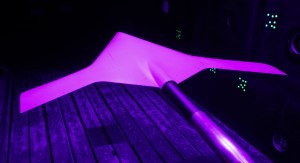Home
Quick Facts
Techniques
Capabilities
Gallery
These techniques address different types of instrumentation for carrying out pressure measurements. However, these techniques, as well as the information that is acquired, can then be applied in new ways to different situations to provide additional capabilities for research and design. These capabilities may provide new forms of information or improve a measurement system.
Pressure may be measured using a variety of different techniques, including placing sensors at finite locations or taking measurements across a continuous smooth surface.
These are some of the common techniques used for measuring pressure:
Pressure Rakes
A rake- or grid-shaped structure of pressure probes typically used to measure flow quality within a test facility.
Static Pressure Taps
Pressure taps can be used in cases where the surface of the instrument is parallel to the flow it is measuring. Taps may be found on a vehicle/model surface or on facility walls to measure static pressure within a facility.
Pressure-Sensitive Paint (PSP)
A paint is applied to model surfaces that contains luminescent molecules that fluoresce to different intensities depending on the air pressure. Unlike static taps which only give measurements at very discrete locations, PSP allows measurement of pressure over a continuous surface.
Pressure Transducers
These are pressure sensors that turn a pressure value into a digital signal. This allows better high-speed measurements, which are often used to measure pressure fluctuations and noise of a system.
Developing Techniques
ATP Test Technology is continually seeking out ways to improve NASA’s techniques for measuring flow variables. New instrumentation can provide fresh insight into flow characteristics and model performance, while improving existing techniques can increase measurement accuracy and give researchers greater detail about flow quality. This information also helps designers, who may use it to make greater improvements to model design.
PSI 8400 Replacement Evaluation and New Higher Speed Scanner Mux Evaluation
A new pressure-measurement system is being evaluated to replace the aging system that is used across NASA’s wind tunnel facilities. This project is being led by NASA’s Ames Research Center, but will eventually also take effect in NASA’s Glenn Research Center and NASA’s Langley Research Center.
+ See “PSI 8400” Image in Gallery
Unsteady PSP in the 9- by 15-Foot Low-Speed Wind Tunnel at Glenn Research Center
Unsteady PSP not only gives pressure measurements across a surface, but also responds more quickly to changing flow conditions. These measurements are meant to provide information for “unsteady” flow, where conditions are rapidly changing. This technology was used on the Open Rotor Propulsion Rig (ORPR) test in the 9×15 Low-Speed Wind Tunnel. (Unsteady PSP photos may be seen in “Quick Facts.”)































